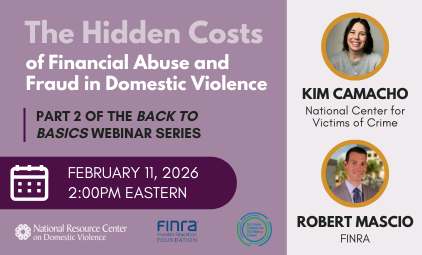By Jennifer Grove, Prevention Outreach Coordinator at the National Sexual Violence Resource Center (NSVRC)
![]()
Many non-profit organizations are tasked with showing funders that their sexual violence prevention work is making a difference. Over the past several years, more programs are coming to understand the role that evaluation plays in carrying out effective, culturally-relevant prevention strategies. Programs are at various levels when it comes to their commitment to evaluation; however, organizational commitment plays a key and vital role. Some see the need to do evaluation, but it seems so big and overwhelming that they don’t know where to start. The NSVRC has developed some great resources to help programs in their evaluation efforts. For example, the online learning course, Evaluating Sexual Violence Prevention Programs: Steps and strategies for preventionists, is an evaluation 101 course specific to sexual violence prevention.
Money may also be a barrier. Many programs think that in order to do good evaluation work, you need a big evaluation budget (not so!). Some programs commit to evaluation by using money to hire a professional evaluation consultant or to hire a staff position dedicated to evaluation. What we see in these situations is that an organization invests all its time and energy into one person doing all of the evaluation work, and then that person leaves and they have to start over from scratch. As part of a solution to that concern, we suggest that organizations see evaluation as a long-term process and integrate it into every aspect of the organization. One way this can be done is by developing a core evaluation team made up of staff that have some responsibility for the evaluation deliverables in the organization. Organizations can then invest in on-going training for this core group with an evaluator (it helps to bring in an evaluator who also understands sexual violence prevention work), and the group can work together on evaluation projects and provide peer support to each other.
The key to the strategy above is flexibility and time. Program staff cannot stop what they are doing to concentrate 100 percent on building their evaluation capacity. The capacity-building work happens at the same time all other work is happening. NSVRC’s bulletin, Organizational support for evaluation: Creating cultures of curiosity in the anti-sexual violence movement, and the accompanying Mapping Evaluation video podcast series where we talk to preventionists in three different states about incorporating evaluation approaches into sexual violence prevention work are great resources to help implement this strategy.
Another fantastic resource that is quickly becoming a favorite is Cultivating Evaluation Capacity: A Guide for Programs Addressing Sexual and Domestic Violence from the VERA Institute of Justice. This guide helps programs measure their evaluation capacity, looking at both areas of strength and areas needing improvement. In addition to this guide, VERA also offers a resource hub including a number of webinars that go along with the topic areas in the guide. As you can see, no matter where your organization is in its evaluation work, there are simple steps you can take to strengthen the commitment to, and capacity for, evaluation.
Are there other resources and tools that you’ve found useful? Please tell us about them in the comments section below.















